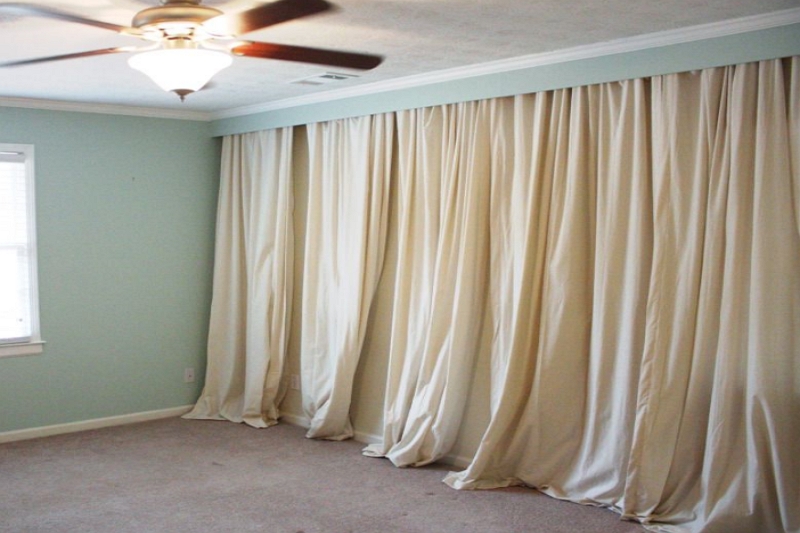Curtains aren’t just for windows; in fact, there are various interesting and quite unusual uses for them. Curtains are a great way to conceal things like hanging rails, open wardrobes, racks, shelves, and other clutters.
However, an entire wall of curtains adds meaning to a room by adding texture, depth, and color. We are going to learn how to cover a wall with curtains in this article.

Steps on Covering a Wall With Curtains
Ensure you have all the necessary tools and materials to get the job done right before moving on the steps listed below on how to cover a wall with curtains. These are what you will need
- Pencil
- Tape measure
- Curtain rod
- Hooks or brackets
- A piece of cardboard
- Drills and screws(This may not be necessary depending on the type of wall brackets or mounts, some wall brackets are sticky and can be attached to a surface without nailing. )
- Compass
- Curtain or drapes
Step #1: Measure the Wall and Mark rod Placement
Using a tape measure, determine the length and width of the wall space you want to cover. Make sure you consider the length of the wall from ceiling to floor if you want to cover the whole wall. The most important thing to remember when hanging a curtain is to make sure the rod is level on the supports.
To do so, mark the wall with a pencil and a piece of cardboard. Create a compass, a right-angle cutout, then cut a right angle out of the piece of cardboard and align it with the corner of the wall. This method is ideal if there is a window on the wall and will help you determine the best placement for the hook.
Place your hook (also known as bracket or hanging plate) on the cardboard and determine where you want your curtain to hang. Create a pencil mark on the cardboard (at the bottom of the hook) once you’ve determined where you want it to hang.
Step #2: Install the hooks
The next step on How to cover a wall with curtains is installation. Remove the backing (usually paper wrappings) from one of your hooks and line it up on the wall using the pencil mark you previously made as a guide.
Attach it firmly against the previously marked surface of the wall. Carry on with the other end in the same manner.
Leave the hooks on for a while, especially if you are using hooks that don’t use screws to ensure they are firmly attached first, and avoid the whole curtain collapsing after the curtain rods’ weight you place the curtain on it.
The procedures are the same for hooks that you don’t nail, that is, hooks that you make to stick on walls rather than being nailed to the surface.
Step #3: Hang the curtains or drapes
For you to create an illusion of space, the drapes should cover the wall as much as possible, so place the rod a few inches from the ceiling. It’s also a good idea to double-check the length of your drapes.
Before hanging a rod, several factors are considered, such as using the proper anchors and tools, but for better aesthetics, make sure the rod is hung at a perfect 1.5 cm or thereabout above the floor.
When the brackets or hooks are in place, it should be easy to slide the drapery rod in, and then you can hang the drapes.
If you’re going to hang curtains instead of drapes, the procedures are the same. However, drapes tend to be a better option as far as looks are concerned when covering walls, while curtains tend to look better on windows, although you can conveniently use both windows and drapes in both situations.
Step #4: Install Wall Sconces Light (optional)
Although this is purely optional, I advise you to consider adding wall sconces to curtain a complete and fancy look.
Step #5: Steam the Drapes
Finally, steam the drapes to get rid of any wrinkles. This process is a vital move because the sconces can cast a light over the cloth, making creases more apparent. Reassemble the furniture, add finishing touches like throw pillows and fresh greenery, and you’re done.
What is the Best Wall Sconces Color Light for my Curtain
A wall sconce is a form of lighting fixture that hangs from the wall instead of the ceiling. In contrast to chandeliers, pendants, and recessed lighting, the light from a wall sconce shines upward rather than downward.
Wall sconces come in various types of sizes and LED color, so when picking a sconce, I suggest you go with a color that fits the curtain that you have already hanged. You can as well be creative by picking a color of your choice.
Where do I place my wall sconces light?
If you’re going to place a sofa close to the curtain, remember to place the sconce a bit higher to create room for the sofa or couch. You do this by following the steps on how to cover a wall with curtains and integrating a couch after that.
Conclusion
Limiting the use of curtains to windows will make you miss out from the beauty curtain can give.
Knowing how to cover a wall with curtains will build a curtained focal point on your wall by following a few simple measures. Also, when picking a curtain, you might go with a color that suits the walls or go bold by trying a look of your own.
